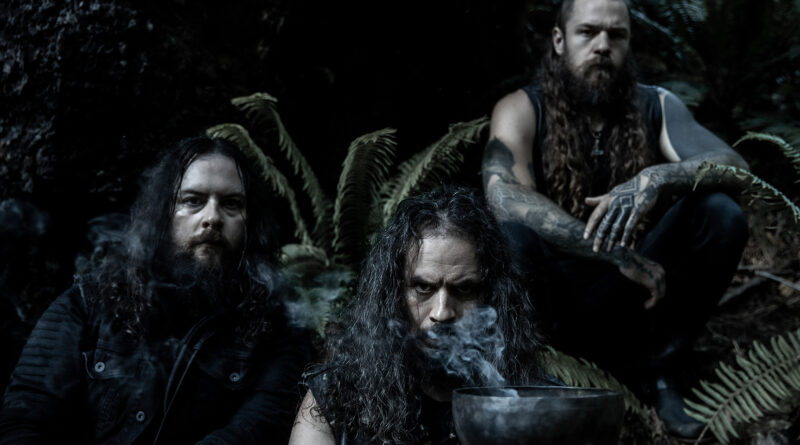Wolves In The Throne Room: Mountains, Myths & Magic
Once the darlings of the underground, WOLVES IN THE THRONE ROOM have long since traded obscurity for notoriety. Nowadays they are one of the most recognisable bands in black metal, but they are also one of the most distinctive. The Olympian trio pay no heed to the cheap thrills of theatrical Satanism. Instead, they have developed their own ritualistic and earthly style of extreme metal which has objectives above and beyond mere entertainment.
“The reason we got into black metal in the first place because when we listened to ULVER for the first time, it was clear to us that it was music which was rising up and out from their surroundings; the mountains, the forests, and the fjords,” explains drummer Aaron Weaver. “It was the music of a very specific place. Listen to Bergtatt [- Et eeventyr i 5 capitler] and close your eyes. You can see those mountains,” he adds, effusively. “That was what we wanted to do.”
Alongside their neighbours and contemporaries, who include AGALLOCH, FAUNA and LEECH, WOLVES IN THE THRONE ROOM would come to define Cascadian Black Metal: a geographic sub-genre of atmospheric black metal which, much like the Norwegian scene which it was influenced by, became a byword for quality. “This is a bioregion defined by plants and animals and geographical features rather than by political delineations,” Weaver explains. “We wanted to make music which rose from the mountains around us; from Cascadia. So we had to ask, what is the mythology which emerges from here?”
Through lyrics, imagery and the atmospheres created through their music, WOLVES IN THE THRONE ROOM have gradually developed a mythos of their own: one which is rooted in European traditions, but displaced into the Pacific North West. “We’re not going to appropriate Native American mythology,” insists Weaver, “because it’s simply not ours to take. At the same time, once we had developed a good relationship with this place and certain plant spirits which exist here, it became clear that they are often the same spirits which the indigenous peoples are in contact with,” he observes. “I feel very honoured to have developed a relationship with some of the totem spirits in Cascadia. It’s been a lifelong process, and something which needs to be done with the utmost respect and care. As modern people, and especially as modern western people, we want to snatch everything. We go to the forest, see the power there and just take it, whether that means cutting down the trees or taking the shamanic power away. That’s very appropriate,” he adds, disapprovingly. “There are consequences to acting in that careless way.”
There is often much in a name and for WOLVES IN THE THRONE ROOM, their name is essentially a mission statement. “Nathan [Weaver] developed the concept for WOLVES IN THE THRONE ROOM at an Earth-First gathering in the late nineties,” his brother recalls. “That’s our background as metalheads: anarchist crust punks, tree-sitting crusties into black metal, doing acid, taking mushrooms and living in the forest trying to find a better path as modern western people; knowing that consumption culture and contemporary politics is just an empty, shallow and soulless world.”
There is a defiant anti-authoritarian and pro-ecological message at the core of the band, which continues to fuel their creative efforts to this day. “We are crafting a different world through art, music and internal journeying,” Weaver explains, “working with spirits, gods, and the earth; not playing the petty game of money, power and war.”
Primordial Arcana is adorned with Amjad Faur’s photography, which blends photorealism with painted textures to create an image which is both vivid and surreal. “Like most of our cover art, this was a collaboration,” explains Weaver. “We knew that we wanted to create an altar, and a lot of those items are from our personal lives: our personal magical practices, things we consider near to our hearts, items from family, and so on. Amjad is a still life photographer influenced, as you might imagine, by the Dutch masters and other traditions in older medieval European still life painting,” he explains admiringly. “It was a lovely experience; he’s a fan, a black metal person, and a faculty member at the local university, so we worked in his studio at the college. It’s a bizarre room full of chainmail that he’s building, every D&D book ever made, and tonnes of painted miniatures; a nerd’s paradise. It was an atmosphere we felt very comfortable in,” he grins. “A lot of people think that it’s a painting, but that’s his magic. That effect is achieved using the camera properly with careful lighting.”
The band has progressed considerably from the primitive beauty of Diadem of Twelve Stars to create Primordial Arcana; a nuanced and eclectic seventh album, over which the brothers Weaver and newcomer Kody Keyworth exerted total creative control. “In the past we’ve been constrained by studio time,” Weaver explains. “There are benefits to having very clear time limits, but because we now have our own studio we don’t have those constraints and the pendulum has swung the other way: now we’re in danger of spending too much time on an album. A lot of bands that have their own studios have fallen into that trap,” he observes, gravely. “Think about Chinese Democracy,” he continues, now grinning, “It took twenty years to make, and must have gotten worse with each iteration! We’re fairly disciplined people, but guided by our hearts, so we’ll work tirelessly on a riff, a song, or a video only until it feels right. A WOLVES IN THE THRONE ROOM song is very distinctive in that way, so we don’t second guess ourselves when we come across that sense of completion.”
Primordial Arcana is out now via Century Media Records (outside of USA and Canada) and Relapse Records (USA and Canada).
Like WOLVES IN THE THRONE ROOM on Facebook.

